
There was an ANADP11 panel about these issues as well as an ‘ESDI Roundtable discussion’ (ESDI = Economic Sustainability of Digital Information) the next day. The latter was organized by Neil Grindley of JISC as a follow-up to earlier work by the US/UK Blue Ribbon Task Force.
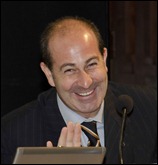 I am going to bring some threads from both meetings together in this post. First of all: in a financial context it is essential that we distinguish digitization (the act of making digital copies) from digital preservation (the act of preserving digital objects). Every time I think we have made this point clear enough, some speaker will mix them up again. So, I begin by citing Bohdana Stoklasová of the small but very active Czech National Library (remember those wonderful young web archivsts at IIPC11!):
I am going to bring some threads from both meetings together in this post. First of all: in a financial context it is essential that we distinguish digitization (the act of making digital copies) from digital preservation (the act of preserving digital objects). Every time I think we have made this point clear enough, some speaker will mix them up again. So, I begin by citing Bohdana Stoklasová of the small but very active Czech National Library (remember those wonderful young web archivsts at IIPC11!): ‘Digital preservation work is invisible, and therefore it is hard to find funding for it. Digitizing new material is much more appealing to funders, because the benefits are immediately visible.’ (Bohdana Stoklasová)
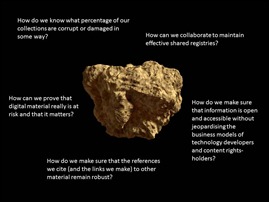 The conversation that followed was mostly about funding and the sustainability of funding (we need long-term money rather than project money), and less about what digital preservation actually costs (the jury is still out on that, as witnessed by a workshop report from an international cost modelling meeting in The Hague last year).
The conversation that followed was mostly about funding and the sustainability of funding (we need long-term money rather than project money), and less about what digital preservation actually costs (the jury is still out on that, as witnessed by a workshop report from an international cost modelling meeting in The Hague last year). Neil Grindley from JISC offered the audience some valuable insights into how funders think: ‘When a funder sees a problem, he wants to throw money at it and solve the problem. But some problems are too large and intractible.’ Comparing DP to an asteroid (slide right), the question is where and when to hit the asteroid to disarm it. Timing is very important, as is scale. Laura Campbell (Library of Congress) agreed that this is an important issue that funders have to address: exactly where will funders’ money be most effective in bringing DP costs down? She agreed with Grindley that funders from all over the world need to talk about this and align their efforts so that the money will be used in the most effective way. Grindley’s conclusions merit further discussion:
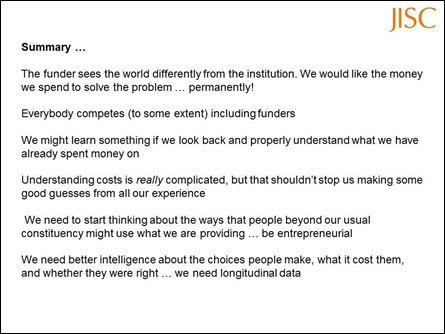

Grassroots initiatives from the US
 Americans tend to have a wonderful way of ‘cutting to the chase’. Aaron Trehub of Auburn University Libraries (photo left) was a case in point:
Americans tend to have a wonderful way of ‘cutting to the chase’. Aaron Trehub of Auburn University Libraries (photo left) was a case in point: ‘An unofficial definition: Digital preservation is the flipside of digital collection-building. Like most infrastructure, it’s invisible, unglamorous, and absolutely necessary’.
‘DP is necessary because: – things (hurricanes, etc.) happen; – hardware breaks; – software crashes; – files get corrupted (‘bit rot’); – somebody hits the wrong button; – somebody drops something; – burning files to CDs and DVDs isn’t enough; – it costs money to restore lost collections.’
‘One solution: distributed digital preservation (DDP): – multiple copies of digital content; – at geographically dispersed locations; – with at least 75-125 miles between them; – preferably out of hurricane pathways; – and across different power grids'; – with different system administrators; – on live media, with audits for integrity; = and in at least 3 copies (LOCKSS = six copies).’
‘DDP basic ingredients: – institutional commitment; – quorum of at least six institutions; – hardware (LOCKSS boxes), – in-house IT support; governance structure; – enough $$$ to cover membership and/or LOCKSS fees (your institution might already be a member!); – enough ‘sweat equity’ to keep it running.’
Such a DDP set-up works even for a poor state such as Alabame, which established the ‘Alabama Digital Preservation Network’ (or ADPNet), in which libraries, museums, archives and other cultural heritage organizations in Alabana share the work of preservation. The network now holds some 3TB of data and has been self-sustaining since 2008. Here is Aaron Trehub’s assessment of ADPNet’s significance and his economic advice for anyone thinking about doing something similar (and do check out the remainder of Aaron’s slides when they become available through the Educopia event website!):
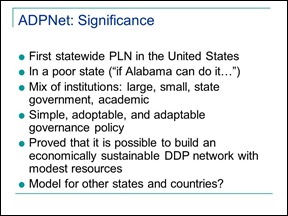
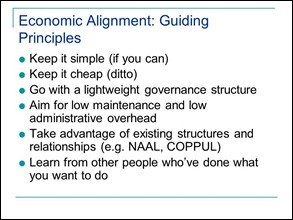
ESDI11 – Economic Sustainability of Digital Information Roundtable
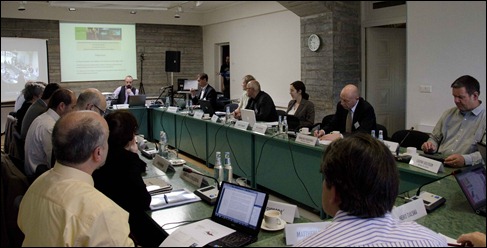 On Thursday, a selection of ANADP11 attendees defied increasing bouts of conference fatigue and gathered to meet with some extremely early risers across the ocean who attended via Skype (also see the tweet threat on #ESDI11 with excellent work by cardcc). Neil Grindley explained that a mini-taskforce consisting of Chris Rusbridge (present LinkedIn profile: ‘retired’ at ‘None’) and Brian Lavoie is following up the work done earlier by the Blue Ribbon Task Force, by trying to turn their 100+ page report ‘Sustainable economics for a digital planet’ into a ‘reference model’, a tool that can help us understand the economic issues and the dynamics of sustainability, provide us with a joint vocabulary, and help us make the case vis-à-vis funders and the public at large. In that sense the model is to work much like the OAIS model did for technical issues – although Chris Rusbridge was quick to add that he does not like the OAIS model much (‘In reality digital archiving is a much more fluid and continuing activity than the closed box idea that is at the centre of OAIS’).
On Thursday, a selection of ANADP11 attendees defied increasing bouts of conference fatigue and gathered to meet with some extremely early risers across the ocean who attended via Skype (also see the tweet threat on #ESDI11 with excellent work by cardcc). Neil Grindley explained that a mini-taskforce consisting of Chris Rusbridge (present LinkedIn profile: ‘retired’ at ‘None’) and Brian Lavoie is following up the work done earlier by the Blue Ribbon Task Force, by trying to turn their 100+ page report ‘Sustainable economics for a digital planet’ into a ‘reference model’, a tool that can help us understand the economic issues and the dynamics of sustainability, provide us with a joint vocabulary, and help us make the case vis-à-vis funders and the public at large. In that sense the model is to work much like the OAIS model did for technical issues – although Chris Rusbridge was quick to add that he does not like the OAIS model much (‘In reality digital archiving is a much more fluid and continuing activity than the closed box idea that is at the centre of OAIS’).
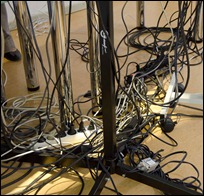 But first a few words on the BRTF work. Sabine Schrimpf of the NCDD’s German colleagues, nestor, reported from the nestor working group which studied the relevance of the report for Germany (Report in German. The working group agreed with many of the Task Force’s findings, but was ‘reluctant’ to accept the report’s recommendations for more public-private partnerships (PPP’s). I felt much the same way when I read the report – the US economy’s dynamics are different from much that goes on in Europe. We accept much more readily that preservation is a public duty and should be funded accordingly. (But note Clifford Lynch’s assessment of PPP’s: ‘Mostly, when there are profits, they go to private partners; if there are losses, they to to the public sector.’)
But first a few words on the BRTF work. Sabine Schrimpf of the NCDD’s German colleagues, nestor, reported from the nestor working group which studied the relevance of the report for Germany (Report in German. The working group agreed with many of the Task Force’s findings, but was ‘reluctant’ to accept the report’s recommendations for more public-private partnerships (PPP’s). I felt much the same way when I read the report – the US economy’s dynamics are different from much that goes on in Europe. We accept much more readily that preservation is a public duty and should be funded accordingly. (But note Clifford Lynch’s assessment of PPP’s: ‘Mostly, when there are profits, they go to private partners; if there are losses, they to to the public sector.’)
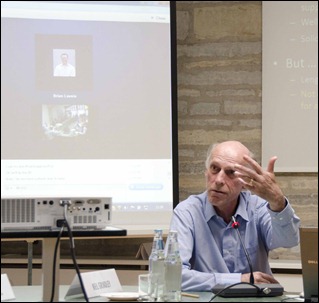 About the reference model: Chris Rusbridge (at right, with Brian Lavoie standing by via Skype, see cable mess above) stressed that the present text is very, very draft (see slides forthcoming on JISC website), but what I saw from it looks promising. It charts all those roles and relationships that make the digital world so different from the analogue world. E.g., what are the properties of sustainability? We do a lot of the work for ‘future users’, but they have no voice yet, so who can function as their ‘current representatives’? Who benefits, who pays; what about free riders? Where do rights holders come in? Etc. (‘Nobody wants preservation; everybody wants the digital asset.’ Chris Rusbridge)
About the reference model: Chris Rusbridge (at right, with Brian Lavoie standing by via Skype, see cable mess above) stressed that the present text is very, very draft (see slides forthcoming on JISC website), but what I saw from it looks promising. It charts all those roles and relationships that make the digital world so different from the analogue world. E.g., what are the properties of sustainability? We do a lot of the work for ‘future users’, but they have no voice yet, so who can function as their ‘current representatives’? Who benefits, who pays; what about free riders? Where do rights holders come in? Etc. (‘Nobody wants preservation; everybody wants the digital asset.’ Chris Rusbridge)
The slides are very much worth reading – all of them will be made available through the JISC website, but here is a taste for you (thanks, Chris, for making these available to me on Sunday afternoon!)
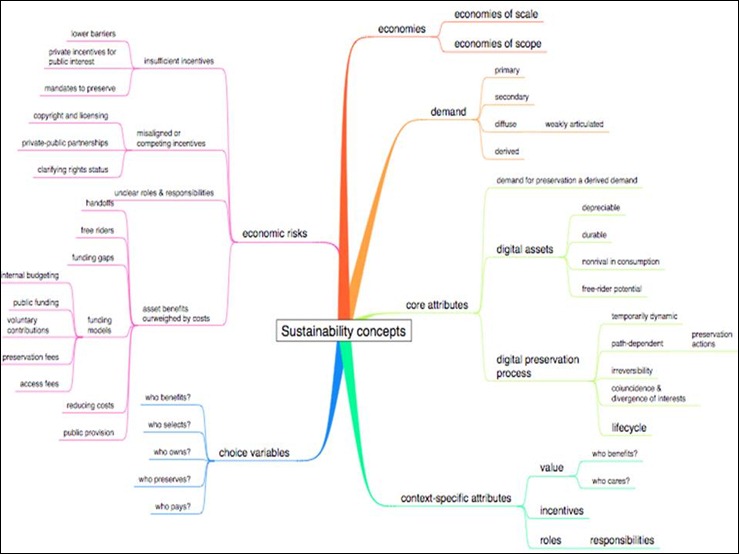
Wouter Schallier of LIBER (the European Association of Research Libraries) reviewed the work that LIBER is doing to make the case for digital information, focussing on the (access) project Europeana, where digital content from all the EU member states is being made available. As an access project, Europeana is presently sustainable, but the future is uncertain. What will happen to Europeana if one of the major aggregators stops doing the work? Off the record doubts could be registered as well as to the added value of Europeana in comparison to Google. Is the Europeana system user-friendly enough?
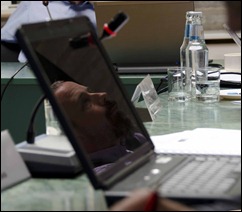 Matthew Loy and Nancy Maron from Ithaka joined the conference by Skype to report on the sustainability research they did for JISC a couple of years ago, with a number of cases studies (full documentation here). Clifford Lynch (Coalition for Networked Information, CNI) commented that in his view the case studies are not classical digital preservation sustainability situations.
Matthew Loy and Nancy Maron from Ithaka joined the conference by Skype to report on the sustainability research they did for JISC a couple of years ago, with a number of cases studies (full documentation here). Clifford Lynch (Coalition for Networked Information, CNI) commented that in his view the case studies are not classical digital preservation sustainability situations.
In the end, everybody agreed that the work Rusbridge and Lavoie are doing on the ESRM can definitely have value for the community, especially in the difficult task of Making the Case vis-à-vis funders and the public at large. But it is complicated business that Lavoie & Rusbridge are trying to chart, and a possible pitfall is that people will start using it as a standard (‘we are ESRM-compliant’). And there is need for a community to support the work and test it. Sabine Schrimpf suggested the nestor working group, but more testing is obviously needed.
Clifford Lynch commented at some time during the meeting that ‘the BRTF report is cited a lot, but I am not sure how well it has been read.’ Matthew Woollard drew attention to the option strategies mentioned in the report. As we do not know what future demand will be for what we are presently curating, the way to save money might be to invest a little money into preservation work now, for say five years, and then decide later what selection from the material merits expensive curation measures. Clifford Lynch added that this strategy is being promoted by the US National Science Foundation as well, as short-term options tend to be cheap.
I leave you with Neil Grindley’s key words from the meeting. To be continued, absolutely.

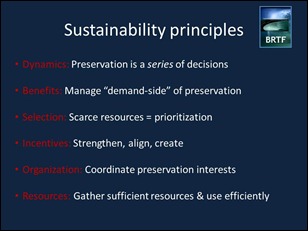
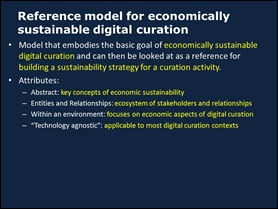
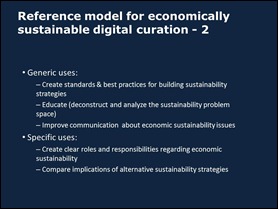
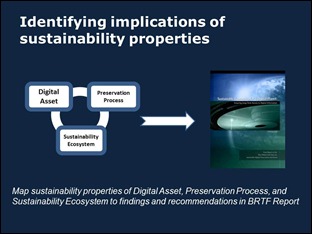
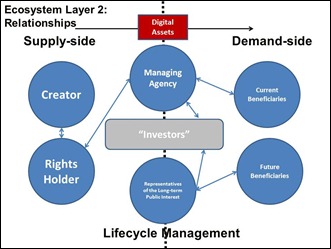


Geen opmerkingen:
Een reactie posten